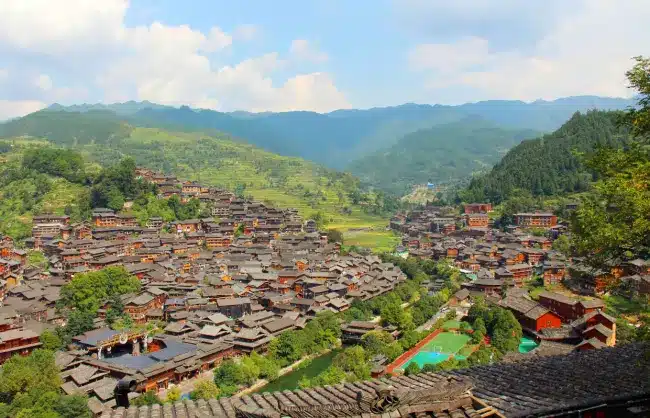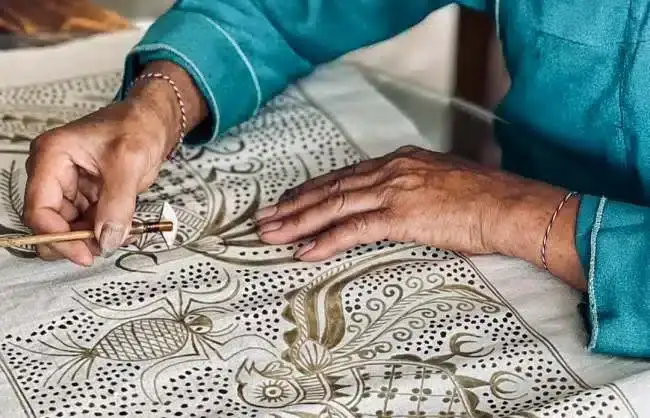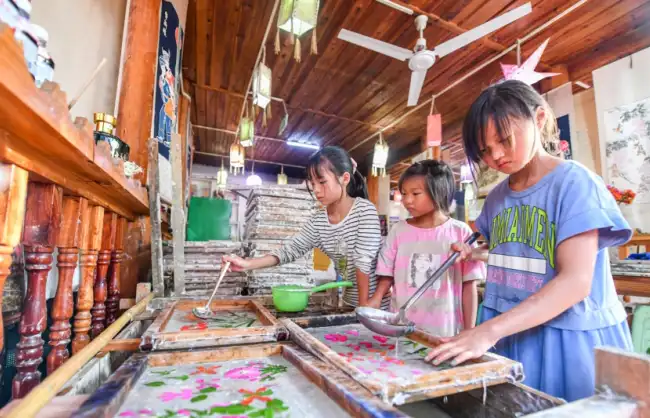Guizhou Province in China is best known for two things, magnificent natural landscapes and rich cultural heritages of various Guizhou ethnic groups. It is one of the provinces with the largest number of ethnic minorities in China. People of over 15 ethnic minorities have lived in Guizhou for generations, such as Miao, Buyei, Dong, Tujia, Yi, and Gelao people.
These ethnicities are still practicing their ancient traditions, including costumes, languages, festivals, folk dances and songs, and craft arts. Many people travel to China hoping to experience the most authentic ethnic culture. Guizhou is the ideal destination to do so. Here’re the top 12 ethnic villages in Guizhou for your China ethnic culture tour.
1. Xijiang Miao Village
Xijiang Miao Village, or Xijiang Qianhu Miao Village, is the largest and most famous Miao village in China. It includes more than ten small villages which are home to more than 6,000 villagers. It is the most popular ethnic village in Guizhou to visit because there’re many ways for you to experience the rich local culture.
As soon as you enter Xijiang Miao Village, you’ll be welcomed with Miao traditional custom, Twelve Welcome Drinks, a gesture to welcome visitors with wine. Villagers dressed in traditional Miao costumes will offer you twelve rounds of drinks to show their hospitality, though it might be a challenge for those who can’t hold their liquor.
As you walk around the village, you’ll see stilted wooden houses layered on top of each other, cut through by winding stone alleyways. During local ethnic festivals, especially the Spring Festival, villagers put on all kinds of performances as celebrations. It’s a good idea to plan your Guizhou trip during these festive times.
Recommended Xijiang Qianhu Miao Village Tours:

2. Langde Miao Village
Langde Miao Village in Kaili city of Guizhou is divided into two parts, Upper Langde Miao Village and Lower Langde Miao Village. Upper Langde Miao Village is open to visitors. Compared with Xijiang Miao Village, it is smaller and less developed with only about 500 villagers.
Despite its size, Langde Miao Village is referred to as the “Miao Ethnic Village Museum,” “Hometown of Chinese Folk Song and Dance Art,” and “Hometown of Lusheng.” It stands out among other ethnic villages in Guizhou for its significant cultural value.
The stilted houses, or Diaojiaolou, are amazing to witness, as the constructions involve no nails or rivets. Women in the village wear long skirts, so Langde is called the “Long Skirt Village.” There’s also a traditional welcome ceremony where villagers will “block the road” with rounds of rice wine. After the toast, there’ll be a music and dance performance with Lusheng, a traditional reed instrument.
Recommended Langde Miao Village Tour: 4 Days Guizhou Highlights Tour

3. Matang Gejia Village
Matang Gejia Village is a village of the Gejia ethnic group, a branch of the Miao ethnic group with its own unique culture and costumes. It is about 18 kilometers (11 miles) from Kaili. You’ll notice the colorful and thoughtful design of their outfits as soon as you walk in the village.
Matang Gejia Village is best known for its batik art, a fabric dyeing technique using natural wax to make exquisite patterns. They are colorful and bright, in shapes of flowers, birds, animals, and geometric shapes. Girls in the village start learning batik skills at the age of eight and become skilled at fifteen. On a Guizhou tour to Matang Gejia Village, you’ll have the chance to experience batik art at a local workshop.
Recommended Matang Gejia Village Tour: 6 Days Guizhou Tour of Guiyang Kaili Fanjingshan

4. Basha Miao Village
Basha Miao Village is best known as the last gunman tribe in China. Locals of this ethnic village in Guizhou are said to be the descendants of ancient warriors. Despite the strict firearm regulations in China, men of Basha are allowed to carry and use guns as a means of preserving their traditions. You’ll notice hunting rifles and knives as part of their outfits. They’ll welcome you with a traditional ceremony.
Recommended Basha Miao Village Tour: 6 Days Guizhou Ethnic Minority Tour
5. Zhaoxing Dong Village
Zhaoxing Dong Village is one of the largest Dong ethnic villages in Guizhou and China with over 1,200 households and a population exceeding 4,000. It has been ranked “one of the six most beautiful villages in China” by Chinese National Geographic and “one of the 33 most attractive destinations in the world” by National Geographic. It’s an essential stop on your China tour if you’re interested in Guizhou ethnic minorities.
The most famous landmark of Zhaoxing Dong Village is the five drum towers. The area is the village’s social and cultural hub. People like to put on performances and celebrations there, including singing, dancing, playing the Lusheng, and hosting festivals.

6. Huanggang Dong Village
Huanggang Dong Village is one of the most primitive ethnic villages in Guizhou. It is marked by several landmarks, the Wind and Rain Bridges, and the five drum towers. The bridges stand at the entrance to the village, carved with dragons and phoenixes to symbolize good fortune and prosperity. You should join the village’s festival celebrations if you travel to Guizhou during those times.
Recommended Dong Village Tour: 5 Days Guizhou Miao and Dong Minority Tour
7. Shiqiao Miao Village
Shiqiao Miao Village, or Stone Bridge Miao Village, is most famous for “Shiqiao Ancient Papermaking.” Its thriving paper industry began as early as Tang Dynasty. The techniques and craftsmanship have been preserved and passed down through generations. Today, there are more than 60 households still practicing their paper-making traditions. You can experience the art yourself on your visit.
Recommended Shiqiao Miao Village Tour: 6 Days Guizhou Cultural Tour with Mount Fanjing

8. Dali Dong Village
Dali Dong Village is a primitive village hidden deep in the mountains of Guizhou. Once you find it, you’ll discover ancient trees, stone-paved alleys with stone carvings, and courtyards that have been home to generations of Dong people. About 2 km (1.2 miles) away, there’s a three-tiered waterfall that you can hike to.
9. Sanbao Dong Village
Sanbao Dong Village is the largest Dong minority village in China. You can experience the most authentic Dong culture here. Every year, during the first and second month of the lunar calendar, there is the oldest and grandest traditional festival of Dong people, “Sama Festival.” There’ll be a huge celebration including the famous Dong pipa performance.
Sanbao Drum Tower is the most iconic landmark in the village. According to the locals, it was built in Qing Dynasty, has since been the social gathering spot for the entire village. It is recognized by Guinness World Record as the tallest drum tower in the world.
10. Kongbai Miao Village
Silver making is one of the three treasures of Miao culture. You can observe it from their stunning outfits and accessories. Kongbai Miao Village is known as the “Last Silversmith Miao Village” in China. There has been a thriving silverwork industry in the village since Qing Dynasty. Every family has a workshop and a silversmith. The craft is passed down in the family, rarely taught to outsiders of the village.
There’s a silverwork workshop displaying beautiful silver jewelries and traditional accessories, including necklaces, bracelets, and earrings. There’re silversmiths on site demonstrating the production process from melting, molding, to beating, welding, and so on. You can participate in the process yourself if you’re interested.
Recommended Kongbai Miao Village Tour: 7 Days Guizhou In-depth Tour
11. Yaoshan Yao Village
Yaoshan Yao Village is home to the Yao ethnic group. The Yao villagers here have the best-preserved ancient traditions, from songs and dances, clothing, architecture, to weddings, sacrifices and other cultural practices. Their cultural preservation has been recognized by UNESCO and named “the living fossil of human civilization.”
Yaoshan Yao Village is built on a mountain slope, overlooking a valley with terraced fields. This ethnic village in Guizhou is the only other place where people can legally own firearms. Villagers are dressed in colorful costumes and embroidered shoes. Women wear long hair coiled on their heads and decorated with silver accessories.
12. Gaodang Buyi Village
Gaodang Buyi Village is home to one of the oldest Guizhou ethnic groups, Buyi people. It is located in Duyun City, about 130 kilometers (81 miles) from Kaili. This quiet village sits in a valley with lush bamboo forests and clear streams flowing through.
Unlike most other ethnic villages we’ve mentioned here, the resident houses of Buyi people are mostly made of stone. They have a rich and ancient stone culture, including stone carving, grinding, building, and worship. There’s a stone museum where you can see the relationship between Buyi people and stones.









